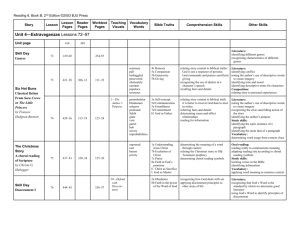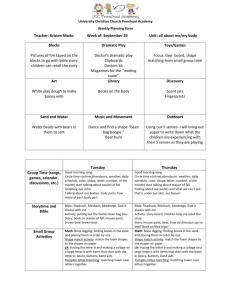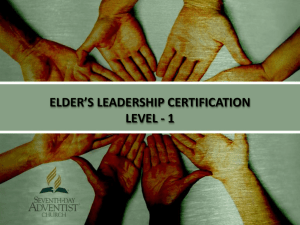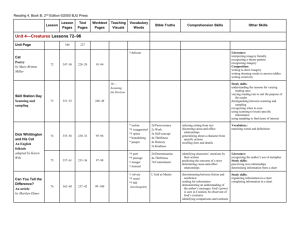Reading 6A, 2nd ed. Lesson Plan Overview
advertisement
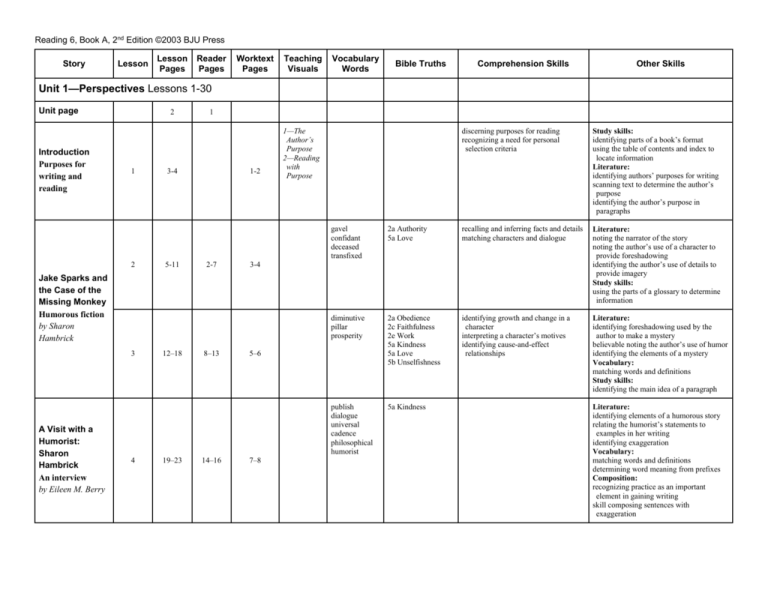
Reading 6, Book A, 2nd Edition ©2003 BJU Press Story Lesson Lesson Pages Reader Pages Worktext Pages Teaching Visuals Vocabulary Words Bible Truths Comprehension Skills Other Skills Unit 1—Perspectives Lessons 1-30 Unit page Introduction Purposes for writing and reading 2 1 2 1 3-4 5-11 1-2 2-7 A Visit with a Humorist: Sharon Hambrick An interview by Eileen M. Berry 4 12–18 19–23 8–13 14–16 discerning purposes for reading recognizing a need for personal selection criteria Study skills: identifying parts of a book’s format using the table of contents and index to locate information Literature: identifying authors’ purposes for writing scanning text to determine the author’s purpose identifying the author’s purpose in paragraphs gavel confidant deceased transfixed 2a Authority 5a Love recalling and inferring facts and details matching characters and dialogue Literature: noting the narrator of the story noting the author’s use of a character to provide foreshadowing identifying the author’s use of details to provide imagery Study skills: using the parts of a glossary to determine information diminutive pillar prosperity 2a Obedience 2c Faithfulness 2e Work 5a Kindness 5a Love 5b Unselfishness identifying growth and change in a character interpreting a character’s motives identifying cause-and-effect relationships Literature: identifying foreshadowing used by the author to make a mystery believable noting the author’s use of humor identifying the elements of a mystery Vocabulary: matching words and definitions Study skills: identifying the main idea of a paragraph publish dialogue universal cadence philosophical humorist 5a Kindness 3-4 Jake Sparks and the Case of the Missing Monkey Humorous fiction by Sharon Hambrick 3 1—The Author’s Purpose 2—Reading with Purpose 5–6 7–8 Literature: identifying elements of a humorous story relating the humorist’s statements to examples in her writing identifying exaggeration Vocabulary: matching words and definitions determining word meaning from prefixes Composition: recognizing practice as an important element in gaining writing skill composing sentences with exaggeration Reading 6, Book A, 2nd Edition ©2003 BJU Press Skill Day Point of view The Squire’s Bride A folktale retold by Peter Christian Asbjörnsen and Jorgen Möe, translated by George Webbe Dasent 5 6 7 8 The Scullery Boy From The Foundling by Linda Hayner 9 10 24–25 26–30 240–41 17–20 31 32–39 40–47 48–55 9–10 3—Who’s Telling? Literature: distinguishing between the use of firstperson narrator and thirdperson narrator widower contradicted coaxing parson tethered courting 5a Love 7d Contentment 7e Humility interpreting the moral of a story interpreting the motives of characters recalling facts and details matching characters and dialogue Literature: identifying third-person point of view noting the author’s use of humor Vocabulary: matching words and definitions 11–12 21–27 28–35 36–42 Literature: identifying third-person point of view noting the author’s use of humor Vocabulary: matching words and definitions 4c Honesty discerning between right and wrong actions and choices 13–14 Vicar scuttle dominated flanked parchment vellum reverently Moslem scullery irksome Literature: identifying elements of setting identifying point of view identifying the author’s use of imagery Study skills: paraphrasing sentences Vocabulary: identifying synonyms to develop word meaning matching synonyms to build vocabulary 15–16 parishioners exploits bunging bodice flounced hedges draymen livery askew 2a Authority 2a Obedience 4c Honesty 5a Courtesy 5a Kindness identifying different characters’ perspectives discerning good and evil characters using adjectives to describe characters completing analogies inferring unstated details identifying fact and opinion interpreting imagery Literature: recognizing the author’s purpose describing humorous elements identifying point of view identifying elements of mood Oral reading: interpreting literature through oral reading 17–18 unlettered breach resume frivolous fortnight embezzlement amenities apoplexy apprentice valise presume 3c Emotional control 4c Honesty 5a Compassion 5a Courtesy 5b Giving 5b Unselfishness 6c Spirit-filled comparing and contrasting characters in a story describing characters’ motives describing characters’ traits sequencing events recalling stated and unstated details Literature: identifying elements of humor Oral reading: interpreting literature through oral reading Vocabulary: matching words and definitions determining word meaning from context Reading 6, Book A, 2nd Edition ©2003 BJU Press Skill Day Syllables and accents 4—Syllables and Swords 5— Accents and Arrows 11 56–57 Structural analysis: dividing words with the VC/CV pattern into syllables (syllable division rule 1) dividing compound words into syllables (syllable division rule 2) determining the accented syllables in twosyllable words without affixes (accent rule 3) determining the primary and secondary accented syllables in two- and threesyllable compound words (accent rule 1) 242–43 recalling facts and details Skill Lesson: The Dewey Decimal System 12 58–62 43–45 19–20 Study skills: using charts to locate information using the Dewey decimal system to classify and locate books distinguishing between skimming and scanning Reading 6, Book A, 2nd Edition ©2003 BJU Press Story Lesson 13 Listening to Katey Humorous fiction by Louise D. Nicholas 14 15 Lesson Pages 63–68 69–73 74–81 16 Reader Pages Worktext Pages Teaching Visuals Vocabulary Words 17 83–93 Author Scrapbook Howard Pyle 18 94–97 Comprehension Skills Other Skills threshold felony gratifying transfixed enterprise appalled 2a Obedience 7d Contentment 2c Faithfulness 2e Work 5a Love determining cause-and-effect relationships contrasting character traits 22–23 endeavor revoked artifacts cul-de-sac dwindling relic wavering capital malice Literature: noting the author’s use of a blending element Vocabulary: determining word meaning from context Study skills: reading a chart to locate information 2e Work 4a Sowing and reaping 5a Love inferring unstated facts and details identifying character growth and change recalling and inferring facts and details 56–63 24–26 latticed arbors trellises resolve consolation sallied witch hazel reveling excavation Literature: evaluating the author’s choice of words identifying simile noting the author’s use of humor identifying types of humor Vocabulary: determining word usage from context Study skills: reading a map 82 27–28 46–50 51–55 21 64–72 Literature: identifying first-person point of view identifying and completing similes noting the author’s use of irony to create humor noting the author’s use of exaggeration to create humor Composition: writing a paragraph in first-person point of view Literature: recognizing the use of flashback in a story identifying flashback parings steward melancholy simpleton The Apple of Contentment A literary folktale by Howard Pyle Bible Truths 3c Emotional control 4c Honesty 5a Love 7d Contentment relating story content to biblical truth: contentment is found in Christ Literature: recognizing the author as the narrator: third-person point of view recognizing the genre literary folktale identifying personification noting the use of understatement in the story Composition: using personification in writing writing creative similes from clichés Vocabulary: matching words and definitions recalling facts and details developing a sense of history Study skills: using a strategy for listening with comprehension 29–30 269–74 8—E.A.R.S. 9—Listen and Learn Reading 6, Book A, 2nd Edition ©2003 BJU Press A Tree for the Wilderness Biblical fiction by Jean Mundell 19 20 98–107 108–14 73–80 81–86 acacia loom incense condemned redemption tormented 1b Repentance and faith 2e Work 5a Love 5c Evangelism and missions 6c Spirit-filled 7d Contentment 8a Faith in God’s promises E. Christ as Sacrifice H. God as Father identifying change in character relating story content to biblical truth: God provides salvation through repentance and faith discriminating between a spirit of gratitude and ingratitude determining cause-and-effect relationships identifying character traits and attitudes applying biblical truth Literature: identifying simile recognizing the genre biblical fiction Study skills: locating verses in the Bible paraphrasing Bible verses Vocabulary: determining word meaning from context hearing lull status jaunty auger vast 2e Cooperativeness recognizing that the rewards of hard work are more than monetary relating story content to biblical principles Literature: demonstrating an awareness of the author’s use of imagery identifying an element of foreshadowing noting how the author reveals characters through their actions applying literary elements—setting, point of view, and main characters Oral reading: reading aloud dialogue and actions in a way that interprets the “heart” of the character Study skills: locating verses in the Bible using a glossary Structural analysis: applying syllable division rules 1 and 2— VC/CV pattern, compound words applying accent rules 1 and 3—compound words, two-syllable words without affixes 35–36 glowered chiseled diagnosis breach winced 2e Diligence 5a Love 5a Thoughtfulness making predictions contrasting characters’ reactions and judging the appropriateness of each interpreting imagery matching characters and dialogue Literature: demonstrating an understanding of figurative language Vocabulary: matching words and definitions 5a Love 5e Loyalty 37–38 client competency violation aghast assessment priority contempt bailiff demonstrating an understanding of the principle that many things are more important than money identifying and interpreting responses of characters giving evidence to support a conclusion Oral reading: reading aloud character dialogue in a way that communicates motive Literature: interpreting imagery Vocabulary: matching words and definitions 31–32 33–34 Aunt Mazey Ain’t Crazy Regional fiction by Dawn L. Watkins 21 22 115–20 121–28 87–92 93–99 Reading 6, Book A, 2nd Edition ©2003 BJU Press Story Lesson 23 Lesson Pages 129–37 Reader Pages 100–107 Worktext Pages 39–40 Teaching Visuals Vocabulary Words malign appease taunting biased ruefully compound The Greater God A missionary story by Sharon Woodruff 24 138 Bible Truths Comprehension Skills 3c Self-control 5a Love 5c Evangelism and missions 6a Bible study 8a Faith in God’s promises 8b Faith in the power of the Word of God 8c Fight 8d Courage I. God as Master demonstrating an understanding of the scope of God’s power recognizing that God will use anyone who is willing noting personal growth of a character relating story content to biblical truth: God’s promises are true identifying character growth and change identifying adverbs and the questions that adverbs answer Mowgli’s Brothers From The Jungle Book by Rudyard Kipling 25 26 139–42 41–42 143–50 108–9 110–16 identifying rhyming words—hink pinks Literature: recognizing an extended metaphor recognizing that rhythm supports meaning identifying the mood of the poem identifying similes, metaphors, and personification Composition: using repetition in writing identifying the emotional responses of characters completing analogies Literature: recognizing the author’s use of sarcasm and irony Oral reading: reading orally to convey the personality of a character Vocabulary: identifying synonyms determining word meaning from context determining word usage from context Structural analysis: applying accent rules 1 and 3—compound words, two-syllable words without affixes 43–44 45–46 Literature: identifying the beginning and end of a flashback identifying flashback Vocabulary: determining word meaning from context Composition: completing a flashback scene Study skills: identifying the main idea and important details of a paragraph identifying statements that support a main idea summarizing with main ideas and important details flanks Wind-Wolves Poetry by William D. Sargent Other Skills 5—Accents threshold and Arrows hydrophobia mean moon scour mangy quarry fostering 4c Honesty 7e Humility 8d Courage Reading 6, Book A, 2nd Edition ©2003 BJU Press 27 28 29 Literature Lesson: Character An article by Morgan Reed Persun 30 151–59 160–67 168–72 173–75 117–25 126–32 133–36 133–36 47–48 49–50 51–52 53–54 cunning veterans monotonous dispute assembly pads cultivated sullenly 4b Purity describing the qualities of characters determining sentence meaning from context identifying character traits recalling and inferring facts and details completing analogies Literature: noting the author’s use of foreshadowing recognizing the author’s use of irony identifying elements of realism in fanciful fiction Vocabulary: determining word meaning from context identifying antonyms Composition: writing descriptive sentences fodder husbandman wicker byre prime fawn marrow gullet 5e Loyalty detecting change in a character Literature: identifying irony recognizing the author’s use of personification identifying elements of realism in fanciful fiction Oral reading: reading orally in a persuasive manner Composition: writing an example of irony Study skills: paraphrase sentences Vocabulary: determine word meaning from context stature illuminate loathed traits industrious Study skills: skimming to get the general idea of an article Literature: identifying methods of revealing character in literature Literature: recognizing and listing five ways that characters are revealed in literature identifying methods of revealing character Composition: brainstorming and recording ideas about a character and how it is revealed writing a character sketch Reading 6, Book A, 2nd Edition ©2003 BJU Press Story Lesson Lesson Pages Reader Pages Worktext Pages Teaching Visuals 244–45 10—The Shape It’s In 11—A Change of Character Vocabulary Words Bible Truths Comprehension Skills Other Skills Unit 2—Victories Lessons 31–52 Unit page Skill Day Types of characters 176 31 32 137 177–78 179–84 138–42 55–56 The Granddaddy of All Frogs Regional fiction by Milly Howard 33 The Nisei An article by Jenna Wright 34 185–90 191–98 143–47 148–53 57–58 59–60 Literature: distinguishing between types of characters: round and flat, dynamic and static 4— Syllables and Swords 5—Accents and Arrows 6—More Syllables and Swords 7— More Accents and Arrows towheaded monologue scrapper brandished gingerly crooning 10—The Shape It’s In degenerated initiated feud awestruck distraught disengaged indignantly incredulous suppressed “in office” prestigious prominent potential evacuate restricted honorary plight occupants secluded contributing 3c Emotional control 2a Authority 2e Work 3b Mind 3c Emotional control 6a Bible study 6b Prayer 6e Forgiveness 8a Faith in God’s promises 8d Courage matching story characters with actions and traits interpreting dialect Literature: identifying elements of setting recognizing the author’s use of humor noting the author’s use of foreshadowing Vocabulary: determining word meaning from context Structural analysis: applying syllable division rules 1, 2, and 4—VC/CV pattern, compound words, and words with affixes applying accent rules 1, 2, and 3— compound words, words with affixes, and two-syllable words without affixes Oral reading: reading orally to interpret dialect predicting outcomes matching story characters with character traits Literature: noting the author’s choice of words noting how the action builds in a story distinguishing between round and flat characters Oral reading: reading orally to interpret dialect Vocabulary: writing sentences to convey word meaning determining meanings of words with prefixes de-, dis-, in recognizing cause-and-effect relationships making inferences identifying prejudice comparing facts and opinions drawing conclusions Vocabulary: matching antonyms determining word meaning from context Study skills: scanning to locate specific details in an article identifying the main idea of an article Reading 6, Book A, 2nd Edition ©2003 BJU Press Skill Day Propaganda 35 199–200 246–47 12—Jump on the Bandwagon 13—Don’t Be Fooled 14—Hear Ye! Hear Ye! 15—All That Glitters 10—The Shape It’s In (optional) 36 201–6 154–58 61 Skill Lesson: Atlas 38 207–11 212–18 159–62 163–67 62–63 64–66 Literature: recognizing four propaganda techniques: bandwagon, name calling, testimonial, and glittering generalities Study skills: locating Bible verses applying biblical truth civil action resolute deducing marred anguished stolidly ambushed banned strafed gravely 1a Understanding Jesus Christ 3c Self-control 5a Compassion 5a Love 5b Giving 6b Prayer 8a Faith in God’s promises C. Basis for Prayer E. Christ as Sacrifice G. Christ as Friend H. God as Father I. God as Master noting the emotional struggles of a character demonstrating an understanding of historical events during World War II relating story content to biblical truth: God is sovereign inferring the motives of characters Literature: recognizing third-person point of view Vocabulary: matching words and definitions devout vandals tojos mutely roused lamented roved 1a Understanding Jesus Christ 1b Repentance and faith 5a Love 5c Evangelism and missions 6e Forgiveness 8b Faith in the power of the Word of God noting change in character relating story content to biblical truths: Christians are to be the light of the world; God is sovereign distinguishing fact and opinion recognizing the attitudes of characters Literature: identifying round and flat characters Vocabulary: determining word usage from context Brethren Nisei Christian fiction by Jeri Massi 37 recognizing the need to think critically when reading and listening topographical precipitation agricultural population densely literacy Study skills: recognizing the purposes of an atlas scanning to locate specific details in an article using graphs and maps to compare information reading bar graphs and line graphs reading a precipitation map determining the appropriate sources of information in an atlas reading maps and interpreting time changes Reading 6, Book A, 2nd Edition ©2003 BJU Press Story Lesson 39 Lesson Pages 219–25 Reader Pages 168–73 Worktext Pages Teaching Visuals Stickball Poetry by Virginia Schonborg The Secret Pitch Humorous fiction by Earl Chapin 41 226–34 235–38 42 239–45 43 246 174–81 182–83 184–89 Bible Truths Comprehension Skills 67–68 2a Authority 2d Goal setting 5a Compassion 5d Communication discerning character traits interpreting meaning from context relating story content to biblical truth: a wise person thinks before he speaks recognizing characteristics of loyalty, compassion, and obedience predicting the meaning of a riddle Literature: recognizing the author’s unique word choices Study skills: reading and interpreting a map Vocabulary: determining word usage from context 4a Sowing and reaping 5a Kindness 5a Thankfulness to men interpreting imagery interpreting symbolism in a riddle recognizing characteristics of loyalty, compassion, and obedience interpreting meaning from context determining character traits drawing conclusions Vocabulary: matching words and definitions 69–70 pommel constraint falter turrets disembarked parapet ricochets describing the person speaking in a poem Literature: identifying anaphora noting the author’s choice of words Oral reading: participating in a choral reading of a poem Composition: using anaphora to write lines of poetry rewriting a poem to reflect another setting troupe formidable ascribed seedy profusely conceded unnerved ingloriously patsy complacent prematurely vehemently chortled primly discerning the motives of characters detecting change in character Literature: describing the mood of the story identifying first-person point of view identifying figurative language noting the author’s use of descriptive verbs identifying simile noting the author’s use of descriptive words Vocabulary: matching words and definitions determining word usage from context Structural analysis: applying syllable division rules 1, 2, and 4—VC/CV pattern, compound words, and words with affixes applying accent rules 1, 2, and 3— compound words, words with affixes, and two-syllable words without affixes 71–72 73–74 4— Syllables and Swords 5—Accents and Arrows 6—More Syllables and Swords 7— More Accents and Arrows 16—PQ3R America’s Favorite Pastime An article by Amy Miller 247–53 Study skills: using the PQ3R study method to read informational text 75–76 16—PQ3R 44 190–94 Other Skills martingale gantlets umbo campaign medals niggling A Ride to Honor Fanciful fiction by Dawn L. Watkins 40 Vocabulary Words 77–78 destined evolve counterparts integration lapsed 4c Honesty 6d Clear conscience recalling facts and details identifying actions that reflect character Study skills: using the PQ3R study method to read informational text plotting related events on a time line Reading 6, Book A, 2nd Edition ©2003 BJU Press 7— More Accents and Arrows Rest in Hope: The Michael Weathers Story A testimony by John Weathers with Eileen M. Berry 45 46 254–60 261–69 195–99 200–207 270–76 208–14 1a Understanding Jesus Christ 6b Prayer 7c Praise 7d Contentment D. Identified in Christ H. God as Father I. God as Master relating story content to biblical truth: all that happens to us is for our good and God’s glory Literature: identifying the perspective from which the story is told identifying how the perspective affects the way the story is presented identifying the theme of the story Study skills: locating and paraphrasing verses from the Bible Structural analysis: identify the schwa sound recognizing that schwa syllables have various spellings recognizing that the accent never falls on a syllable with a schwa sound recognizing that in words with the schwa ending /shǝn/, the accent usually falls on the syllable that precedes the ending applying accent rule 4—schwa syllables Vocabulary: matching words and definitions dramatis personae predecessors suitors bolster lavish inclined beseech chambers doddering indistinct compose beguiles dowry impertinent implore insufferable comport vagabond disposed station arsenal pauper 3c Emotional control 7d Contentment 7e Humility demonstrating an understanding of arranged marriages and class distinctions from a historical perspective comparing and contrasting characters relating story content to biblical truth: before honor is humility making predictions completing analogies drawing conclusions Literature: recognizing puns as word play that colors the dialogue Oral reading: reading orally to convey character traits Vocabulary: matching words and definitions refrain inquiring indulgence oblivious shrew disposition duration 2b Servanthood 2f Enthusiasm 3c Emotional control 5a Love 5b Unselfishness 7e Humility interpreting meaning from context inferring unstated facts and details evaluating characters’ motives recognizing noble qualities of unselfish love identifying character traits Oral reading: reading orally to demonstrate emotional responses of characters Vocabulary: interpreting word meaning from context 79–80 81–82 The ProudMinded Princess A folktale dramatized by Dawn L. Watkins 47 stimulated grafts 83 Reading 6, Book A, 2nd Edition ©2003 BJU Press Story Lesson 48 The ProudMinded Princess A folktale dramatized by Dawn L. Watkins 49 Lesson Pages 277–85 Reader Pages 215–22 286 Worktext Pages Teaching Visuals Vocabulary Words 84–86 10— The Shape It’s In 11—A Change of Character royalty aught reign “on my account” outriders precision resplendent regalia devices Bible Truths 2e Work 5b Giving 7d Contentment Comprehension Skills relating story content to personal experience comparing and contrasting story events matching characters and dialogue projecting characters beyond the plot 87–88 287 encompasses integral Literature Lesson: Setting An article by Morgan Reed Persun 51 288–92 223–26 89–90 52 293–95 223–26 91–92 Unit page 296 227 Oral reading: reading orally with confidence before others identifying voice expression Literature: identifying themes that are carried out throughout the play Literature: recognizing the influence of setting on a story identifying types of setting: integral and backdrop recognizing setting as a symbol identifying details of a story’s setting Study skills: skimming to get the general idea of an article inferring details of a setting Unit 3—Ventures Lessons 53–71 Literature: demonstrating an understanding of static and dynamic characters recognizing foreshadowing recognizing and interpreting puns identifying types of characters Composition: writing a pun Oral reading: reading orally to reveal a change in a character Vocabulary: determining word usage from context Oral reading: reading orally with varied voice expression Acting: identifying ways to interact with other characters identifying verbs that describe motivation of characters recognizing change in a character 50 Other Skills Composition: brainstorming and recording ideas about setting writing the details of a setting Reading 6, Book A, 2nd Edition ©2003 BJU Press Skill Day Types of conflict 53 297–98 248–49 17—What’s the Problem? 17—What’s the Problem? (optional) 54 299–305 228–33 93–94 Literature: distinguishing between external and internal conflict distinguishing among the types of conflict: man vs. self; man vs. man; man vs. society; and man vs. nature expeditions isolation hostile portal wharves dehydrated reconstituted excursions trek commune toboggan deliberate stint 5b Unselfishness 6a Bible study 6b Prayer relating story content to biblical truth: personal Bible study and prayer are important Literature: noting the author’s use of simile noting the author’s use of metaphor noting the author’s use of details to create setting recognizing foreshadowing identifying the conflict in the story distinguishing between metaphors and similes Composition: writing metaphors and definitions Vocabulary: matching words and definitions Study skills: using a Venn diagram to compare and contrast information exposure temperate maroon resort poaching dike wafting moored navigation recoiled rummaged glowered gauze 7e Humility 8d Courage comparing and contrasting characters recognizing the value of respect and cooperation interpreting word meaning from context distinguishing between good and evil characters Literature: identifying the conflict in the story completing a story map Vocabulary: matching words and definitions Study skills: reading a catalog order form Antarctica Christian fiction by Jeri Massi 55 306–13 234–40 95–97 18—Prose or Poetry? Skill Day Prose and poetry 56 314–15 250–51 Literature: recognizing characteristics of prose and poetry classifying literature as prose or poetry on a writing spectrum distinguishing the differences between prose and poetry Reading 6, Book A, 2nd Edition ©2003 BJU Press Poems of Day Sunrise Poetry by Emily Dickinson Weaver of Light Poetry by Louise D. Nicholas amethyst bobolink 57 316–19 241–42 98 comparing and contrasting two poems Literature: identifying personification recognizing the poet’s use of figurative language recognizing and marking rhyme scheme Reading 6, Book A, 2nd Edition ©2003 BJU Press Story Lesson 58 Lesson Pages 320–27 Reader Pages 243–49 Worktext Pages Teaching Visuals 99–100 Ornan the Jebusite Biblical fiction by Becky Davis 17—What’s the Problem? 59 328–34 250–55 101–2 Vocabulary Words Bible Truths Comprehension Skills tedious winnowing deft loath impregnable boisterously prominence pragmatic sham compelled 1c Separation from the world 4b Purity 5c Evangelism and missions 6b Prayer identifying character traits comparing the story to biblical content relating story content to biblical truth: a Christian’s actions affect his testimony distinguishing traits of story characters Study skills: reading a map to determine locations and directions drawing a map with a map key privy to vulnerable indulge shrines expediency pestilence petitioning plague contrite 4a Sowing and reaping 8d Courage H. God as Father identifying character growth and change relating story content to biblical truth: God punishes sin yet is loving and forgiving identifying the sequence of character growth and change Literature: identifying the main conflict in the story: man vs. self recognizing the genre biblical fiction distinguishing types of conflict Vocabulary: matching words and definitions 8b Faith in the power of the Word of God Skill Lesson: Bible Reference Tools An article by Tammie Jacobs Shipwrecked! From The Swiss Family Robinson by Johann Wyss 60 61 335–40 341–47 256–59 260–65 Study skills: identifying five types of Bible reference tools: Bible concordance, Bible commentary, Bible dictionary, Bible encyclopedia, and Bible atlas scanning to locate specific details in an article using a concordance to locate information locating verses in the Bible reading a Bible atlas map comparing and contrasting a Bible atlas map and a modern-day map 103–4 105–6 Other Skills resign perilous refuge erected subside adieu transports nautical undiminished ballast capsizing laden sumptuous indulgences 6b Prayer 7c Thankfulness to God 8a Faith in God’s promises C. Basis for Prayer I. God as Master relating story content to biblical truth: God’s will is perfect identifying character traits recalling facts and details applying biblical truth to story content Literature: identifying the narrator and the point of view of the story describing the mood of a situation Vocabulary: interpreting word meaning from context Study skills: locating verses in the Bible Reading 6, Book A, 2nd Edition ©2003 BJU Press 62 Author Scrapbook Daniel Defoe 63 64 348–52 266–69 353–56 357–63 107–8 275–78 270–75 16—PQ3R 65 364–71 276–82 283–85 recalling facts and details developing a sense of history Study skills: using a strategy for listening with comprehension taking notes and making drawings to aid in listening evaluating the characters’ responses inferring unstated facts and details describing traits of story characters comparing and contrasting story characters distinguishing character traits and actions Vocabulary: matching words and definitions writing sentences to convey word meanings nuisance intrigued taxiing straightaway 6e Forgiveness 7d Contentment 8a Faith in God’s promises 8b Faith in the power of the Word of God 8d Courage D. Identified in Christ I. God as Master interpreting the types of conflict in the story inferring and recalling story details recognizing character growth and change relating story content to biblical truth: God is sovereign and He makes no mistakes drawing conclusions Literature: identifying the types of conflict in the story: man vs. self; man vs. man; man vs. nature noting the author’s use of foreshadowing identifying the importance of details to the story plot Study skills: using the PQ3R method of study 110–12 113–14 Literature: identifying the main conflict: man vs. nature Vocabulary: matching words and definitions 5a Kindness 5a Love 5e Loyalty 6c Spirit-filled 7d Contentment 7e Humility characterization 372–76 inferring cause-and-effect relationships interpreting meaning from context recalling facts and details identifying cause-and-effect relationships appraising poachers traitor tarpaulin intersect crisis trite stereotypical 66 2e Industriousness 7d Contentment 8—E.A.R.S. 9—Listen and Learn 109 The Quisling Hunt Regional fiction by Gloria Repp A Visit with a Mystery Writer: Gloria Repp An interview by Eileen M. Berry devise due course famously improvised sow tureen drawing savage superficial analyze Literature: identifying a characteristic of a good mystery story relating the mystery writer’s statements to examples in her writing demonstrating an understanding of how an author plans for consistent and interesting characters Study skills: conducting and recording an interview identifying irrelevant information identifying the main idea of a paragraph Reading 6, Book A, 2nd Edition ©2003 BJU Press Story Lesson 67 Lesson Pages 377–85 Reader Pages 286–93 Worktext Pages Teaching Visuals Vocabulary Words 115–16 1—The Author’s Purpose 17—What’s the Problem? yeoman muck unabashed curry steed docile brandishing boar wretches swath venison roust gules azure burnished incredulous greaves lure pauldrons quandary repugnant reverie aspire entourages Yeoman Knight Historical fiction by Dawn L. Watkins 68 Skill Day Etymologies 69 386–93 294–300 394–95 117–18 252–53 19— Word Equations 396–400 301–4 401–3 301–4 Other Skills 2d Goal setting 3a Self-concept 4c Honesty 5a Courtesy 7e Humility 8c Fight 8d Courage recognizing the character traits of wit, courage, and duty relating story content to biblical truth: a Christian must put on the whole armor of God noting how a character’s actions reveal character traits recalling and inferring acts and details Vocabulary: determining word usage from context clues 2e Work 4a Sowing and reaping 4b Purity 4d Victory recognizing the character traits of wit, courage, and duty relating story content to biblical truth: those who are faithful in small things can be trusted with greater responsibilities Literature: identifying a simile recognizing the author’s use of imagery noting the author’s use of setting to reflect the character’s emotions identifying types of conflict identifying the author’s purpose for writing Vocabulary: determining word usage from context clues 119 Study skills: skimming to get the general idea of an article Literature: identifying elements of plot describing how conflict affects plot describing how a good plot supports a theme determining the plot sequence of a story 120 Literature: recognizing the function of plot Composition: brainstorming and recording ideas about plot and how it is developed determining a plot sequence in preparation for writing a story Literature Lesson: Plot An article by Morgan Reed Persun 71 Comprehension Skills Vocabulary: determining word meanings from prefixes, suffixes, and Latin and Greek roots determining the etymology of a word building words based on etymologies intuitively elements inciting denouement 70 Bible Truths

